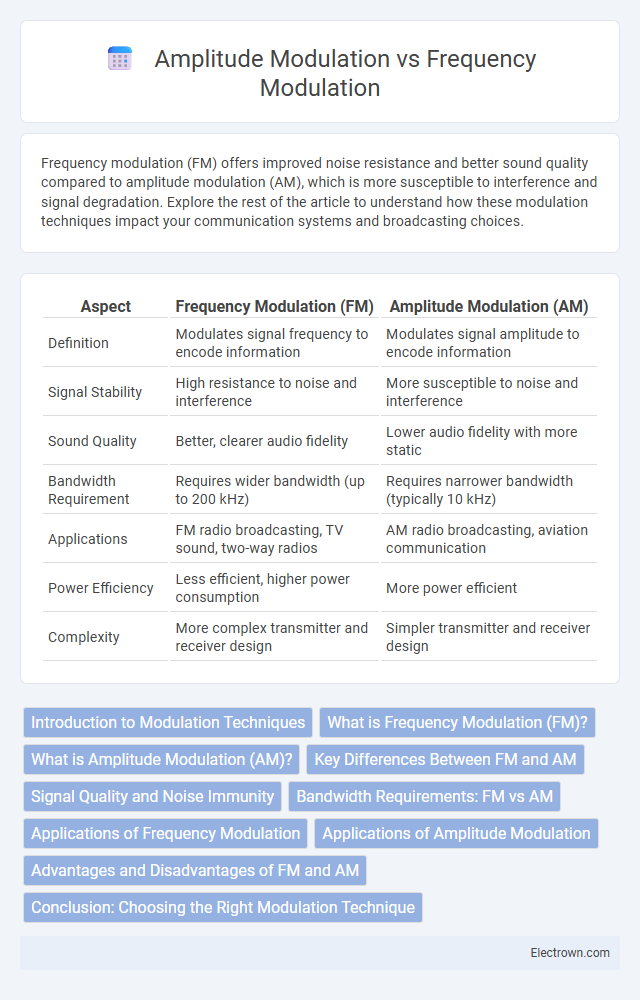Frequency modulation (FM) offers improved noise resistance and better sound quality compared to amplitude modulation (AM), which is more susceptible to interference and signal degradation. Explore the rest of the article to understand how these modulation techniques impact your communication systems and broadcasting choices.
Table of Comparison
| Aspect | Frequency Modulation (FM) | Amplitude Modulation (AM) |
|---|---|---|
| Definition | Modulates signal frequency to encode information | Modulates signal amplitude to encode information |
| Signal Stability | High resistance to noise and interference | More susceptible to noise and interference |
| Sound Quality | Better, clearer audio fidelity | Lower audio fidelity with more static |
| Bandwidth Requirement | Requires wider bandwidth (up to 200 kHz) | Requires narrower bandwidth (typically 10 kHz) |
| Applications | FM radio broadcasting, TV sound, two-way radios | AM radio broadcasting, aviation communication |
| Power Efficiency | Less efficient, higher power consumption | More power efficient |
| Complexity | More complex transmitter and receiver design | Simpler transmitter and receiver design |
Introduction to Modulation Techniques
Frequency modulation (FM) varies the frequency of the carrier signal in direct proportion to the amplitude of the input signal, ensuring better noise resistance and clearer sound quality compared to amplitude modulation (AM), which changes the amplitude of the carrier signal while keeping the frequency constant. AM is simpler and more bandwidth-efficient but more susceptible to noise and interference, making FM preferable for high-fidelity audio transmissions. Both modulation techniques form the foundation of modern communication systems, with FM predominantly used in radio broadcasting and AM in long-distance and aeronautical communication.
What is Frequency Modulation (FM)?
Frequency Modulation (FM) is a method of encoding information in a carrier wave by varying its instantaneous frequency according to the amplitude of the input signal. Unlike Amplitude Modulation (AM), where the carrier wave's amplitude changes, FM maintains a constant amplitude, providing greater resistance to signal degradation and noise interference. FM is widely used in radio broadcasting, telecommunications, and audio transmissions due to its improved sound quality and robustness.
What is Amplitude Modulation (AM)?
Amplitude Modulation (AM) is a technique used in electronic communication where the amplitude of a carrier wave is varied in proportion to the message signal while the frequency remains constant. This method enables the transmission of audio information over radio waves by encoding sound onto a high-frequency carrier signal. Your radio receiver then demodulates the signal, extracting the original audio content from the varying amplitude of the waveform.
Key Differences Between FM and AM
Frequency Modulation (FM) varies the carrier wave's frequency to encode information, while Amplitude Modulation (AM) alters the carrier wave's amplitude. FM provides better noise resistance and higher sound quality due to its constant amplitude, making it ideal for music broadcasting. AM signals have a longer range and simpler receiver design but are more susceptible to interference and static.
Signal Quality and Noise Immunity
Frequency Modulation (FM) provides superior signal quality and noise immunity compared to Amplitude Modulation (AM) due to its method of encoding information in frequency variations rather than amplitude changes, which makes FM signals less susceptible to amplitude-based noise and interference. FM's ability to maintain consistent signal integrity in the presence of static and electrical noise results in clearer audio and more reliable communication for Your applications. In contrast, AM signals often experience degradation from noise, causing reduced sound fidelity and making FM the preferred choice for high-quality broadcasting and communication systems.
Bandwidth Requirements: FM vs AM
Frequency Modulation (FM) typically requires a wider bandwidth compared to Amplitude Modulation (AM) due to its varying frequency deviation, which enhances signal fidelity and reduces noise interference. AM signals occupy a narrower bandwidth, generally twice the highest audio frequency, but are more susceptible to static and signal degradation. Your choice between FM and AM should consider the trade-off between bandwidth availability and the desired audio quality or noise resilience.
Applications of Frequency Modulation
Frequency Modulation (FM) is widely used in high-fidelity audio broadcasting, such as FM radio stations, due to its superior noise resistance and better sound quality compared to Amplitude Modulation (AM). FM is essential in two-way radio communications, including emergency services, police, and aviation, where clear and reliable transmission is critical. Your preference for FM technology enhances signal clarity and reduces interference, making it the ideal choice for music broadcasting and voice communication.
Applications of Amplitude Modulation
Amplitude Modulation (AM) is widely used in commercial radio broadcasting for transmitting voice and music over long distances due to its simplicity and effective coverage. AM is also critical in aviation communication systems, where reliable, clear voice transmission is essential for air traffic control and pilot exchanges. Industrial applications utilize AM in signal processing and telemetry for monitoring and controlling machinery, benefiting from its robustness in varied environmental conditions.
Advantages and Disadvantages of FM and AM
Frequency Modulation (FM) offers superior noise resistance and better sound quality compared to Amplitude Modulation (AM), making FM ideal for high-fidelity audio broadcasts, but it requires a larger bandwidth and more complex receivers. Amplitude Modulation (AM) provides simpler technology and longer transmission range, especially effective for long-distance communication, but it suffers from greater susceptibility to noise and interference, resulting in lower audio quality. FM's advantages in signal clarity are balanced by higher bandwidth demands, while AM's efficiency comes at the cost of signal degradation in noisy environments.
Conclusion: Choosing the Right Modulation Technique
Frequency Modulation (FM) offers superior noise immunity and better sound quality, making it ideal for high-fidelity audio broadcasting, while Amplitude Modulation (AM) provides simpler implementation and longer transmission ranges suited for talk radio and emergency broadcasts. The choice depends on application requirements such as signal robustness, bandwidth availability, and equipment complexity. Selecting the right modulation technique optimizes communication system performance by balancing quality, coverage, and cost.
Frequency Modulation vs Amplitude Modulation Infographic

 electrown.com
electrown.com